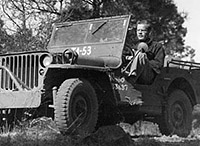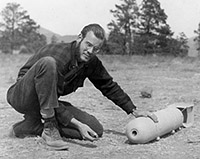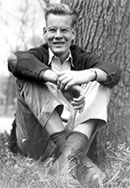Al Bartlett - Los Alamos, WWII
Al Bartlett worked for 25 months in Los Alamos, beginning in 1944. Here are excerpts from the Fall, 2005 interview of Al Bartlett by Paul Nachman:
About Al Bartlett
Photos
Al Bartlett - In Memoriam
Al Bartlett video tribute
Read the article Voices of the Manhattan Project New York Times, (October 28, 2008).
"A lifetime ago they were plucked from graduate schools and university laboratories in the midst of World War II and and told to report to obscure locations to work on building an atomic bomb. Their work changed the world. Earlier this month, veterans of the Manhattan Project shared their experiences and feelings about the bomb at a gathering at the City University of New York."
AAB: That fall [1942], I took my first college physics course. I enjoyed it and did well. At Colgate, it was night and day, summer and winter, just physics and math and very little else. I graduated in June of '44. Then what? One of my professors heard that there was an address, "Box 1663," in Santa Fe, New Mexico, where they were hiring physicists. Sounded like adventure to me, so I applied didn't know what it was, and they didn't tell me and I was accepted.
My only instructions were to appear at 109 E. Palace in Santa Fe. So, after graduation, I hitchhiked home to Ohio, and to Springfield where a friend helped me get two new International Harvester trucks from the factory. I drove them to a dealer in Oklahoma City and then hitchhiked to Amarillo. All my life I'd wanted to ride a freight train, so I hopped a freight in Amarillo to Belen, south of Albuquerque. Then I hitchhiked to Santa Fe and reported to 109 E. Palace. The lady there in the office was Dorothy McKibben. She did some paperwork and had me get on an Army bus in the alley in back. It took me off through the desert and canyons up to Los Alamos. Quite an experience! I arrived on July 18, 1944 and worked for 25 months there.
PN: So what was your job at Los Alamos?

Albert Allen Bartlett driving a jeep to a remove site at Los Alamos, circa 1945. At the time, he was working with the photographic group that was testing cameras and their responses to very bright flashes.
AAB: Mass spectrometry of plutonium. It wasn't that I knew anything about mass spectrometry, but this was just at a time when the first plutonium was coming down from Hanford, and there was some indication that, in addition to the principal isotope 239Pu, there may be some 240Pu from an extra neutron capture in the Hanford reactors.
Now 240Pu has a high spontaneous fission probability, which would upset all their [bomb] calculations. So they wanted to know how much was there. They'd just requisitioned a mass spectrometer from a lab in Washington, DC, about the time I got there, and Bob Thompson, who'd been a PhD student with Al Nier at Minnesota, was setting it up. Bob took me on me sort of as an apprentice and took a real interest in me, telling me what I needed to study, giving me a stack of reprints to read, etc. He was very helpful. So we made the first measurements of the isotopic constitution of plutonium coming out of the reactors.
PN: While you were there "on the Hill," did you meet any of the physicists of the Heroic Generation?

Albert Allen Bartlett with one of the magnesium bombs used to test special high-speed cameras, circa 1945.
AAB: Well I certainly encountered them. Fermi on the ski slopes... Neils Bohr sitting down next to me at the soda fountain... And I went to the scientific seminars, where you'd see all the big shots.
PN: From the dates you gave, you must have been at Los Alamos for awhile after the war ended.
AAB: Right after the end of the war I worked on the weapons tests at Bikini Atoll. There was no longer pressure to do mass spectrometry, so I joined a high-speed photography group, setting up high-speed movie cameras out in the Pacific, so I went out there and saw the first test, the air drop and then came home and we got married and, in the fall of '46, I started graduate school at Harvard.

